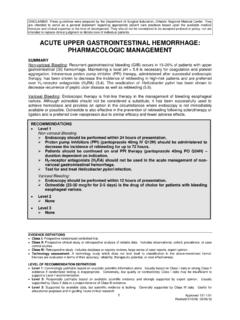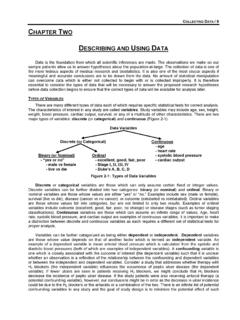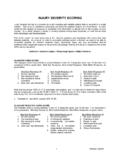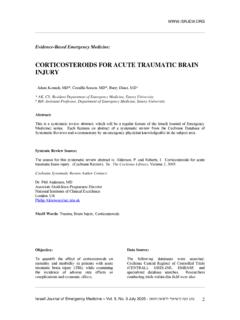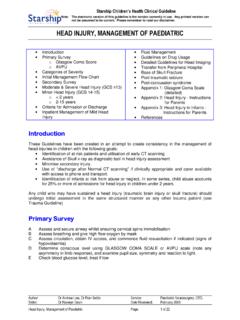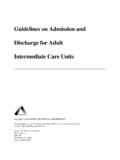Transcription of Severe Traumtic Brain Injury - SurgicalCriticalCare.net
1 DISCLAIMER: These guidelines were prepared by the Department of Surgical Education, Orlando Regional Medical Center. They are intended to serve as a general statement regarding appropriate patient care practices based upon the available medical literature and clinical expertise at the time of development. They should not be considered to be accepted protocol or policy, nor are intended to replace clinical judgment or dictate care of individual patients. EVIDENCE DEFINITIONS Class I: Prospective randomized controlled trial. Class II: Prospective clinical study or retrospective analysis of reliable data. Includes observational, cohort, prevalence, or case control studies.
2 Class III: Retrospective study. Includes database or registry reviews, large series of case reports, expert opinion. Technology assessment: A technology study which does not lend itself to classification in the above-mentioned format. Devices are evaluated in terms of their accuracy, reliability, therapeutic potential, or cost effectiveness. LEVEL OF RECOMMENDATION DEFINITIONS Level 1: Convincingly justifiable based on available scientific information alone. Usually based on Class I data or strong Class II evidence if randomized testing is inappropriate. Conversely, low quality or contradictory Class I data may be insufficient to support a Level I recommendation.
3 Level 2: Reasonably justifiable based on available scientific evidence and strongly supported by expert opinion. Usually supported by Class II data or a preponderance of Class III evidence. Level 3: Supported by available data, but scientific evidence is lacking. Generally supported by Class III data. Useful for educational purposes and in guiding future clinical research. 1 Approved 3/31/2009 Revised 2/6/2013, 2/17/2014, 3/29/2016, 5/4/2017 Severe traumatic Brain Injury MANAGEMENT SUMMARY traumatic Brain Injury (TBI) is a major cause of death for all age groups in the United States, contributing to over 30% of trauma-related deaths.
4 Protocolized management of Severe TBI (defined as a post-resuscitation Glasgow Coma Score (GCS) 8) has been demonstrated to improve patient outcomes. Primary endpoints in the management of Severe TBI include minimizing cerebral edema and intracranial pressure (ICP) while simultaneously optimizing cerebral perfusion pressure (CPP) (CPP = MAP ICP) and tissue oxygenation to reduce secondary ischemic Injury . RECOMMENDATIONS Level 1 None Level 2 If ICP monitor in place, maintain ICP < 22 mmHg and CPP 60 mmHg Maintain patient temperature 36-37 Celsius; consider early antipyretics and cooling blankets Do not administer high-dose steroids in TBI Protect the patient's airway and intubate if GCS 8 Maintain oxygenation (PaO2 80-120 mmHg) and normocarbia (PaCO2 35-40 mmHg) Elevate head of bed 30 degrees at all times Consider ICP monitor if GCS 8 (after resuscitation) AND concern for elevated ICP on imaging or physical examination Provide judicious sedation and analgesia to control pain and agitation Initiate norepinephrine if CPP < 60 mmHg despite appropriate volume resuscitation If ICP is persistently > 22 mmHg: Administer sodium chloride 250mL IVPB x1 over 15 minutes o Alternative therapy.
5 Mannitol gm/kg IV x 1 Order serum sodium levels every 4 hrs (and serum osmolality if using mannitol) Consider neuromuscular blockade for refractory ICP Initiate seizure prophylaxis for the first 7 days post- Injury Consider continuous EEG to rule out non-convulsive status epilepticus Ensure appropriate early nutrition, stress ulcer, and deep venous thrombosis prophylaxis Level 3 Maintain MAP 80 mmHg if an ICP monitor is unavailable Maintain hemoglobin > 9 gm during the patient s critical illness If ICP is sustained > 22 mmHg and patient has been admitted > 24 hours, consider short-term hyperventilation to a PaCO2 of 30-35 mmHg Consider decompressive craniectomy / craniotomy for patients with a surgical lesion.
6 If the patient is not a surgical candidate, consider pentobarbital coma for refractory ICP 2 Approved 3/31/2009 Revised 2/6/2013, 2/17/2014, 2/29/2016, 5/4/2017 traumatic Brain Injury TIERS OF THERAPY TIER ZERO The following interventions should be implemented in all patients with TBI: Maintain target MAP 80 mmHg if no ICP monitor is in place Administer supplemental oxygen to maintain SpO2 > 92% Elevate head of bed to 30 degrees Maintain head in neutral position to avoid jugular vein constriction Maintain serum sodium 140 mEq/L with isotonic intravenous fluids (no dextrose) Correct coagulopathy with the appropriate reversal agent in life-threatening bleeds Patient on warfarin AND INR > 2: FEIBA NF 1000 units IV-syringe infusion over 20 minutes Patient on Factor Xa inhibitors: o FEIBA NF 2000 units IV-syringe infusion over 20 minutes o Tranexamic acid 1g IVPB x 1 over 10 minutes Patient on dabigatran.
7 Idarucizumab gms IVPB q 10 minutes x 2 doses Consider platelet transfusion in patients requiring neurosurgical intervention and documented platelet dysfunction (positive PFA-Plavix) secondary to ADP-inhibitors ( clopidogrel, prasugrel, ticagrelor or ticlodipine) (see Antiplatelet Agent Reversal in Adults with traumatic Intracranial Hemorrhage guideline) Maintain normothermia (temperature 36-37 Celsius) Acetaminophen 650 mg PO/PT q 4 hrs scheduled if temperature > 37 Celsius Consider Ibuprofen 800 mg PO/PT q 6 hrs (if unable to control with acetaminophen) Consider utilizing the Arctic SunTM cooling device if unable to maintain normothermia Maintain serum glucose 70 mg/dL and 180 mg/dL Ensure early appropriate nutritional support (within 24 hrs.)
8 Post-pyloric feeding preferred) Prevent deep venous thrombosis (DVT) initiate subcutaneous heparin within 24 hours of Injury Initiate gastrointestinal stress ulcer prophylaxis in mechanically ventilated patients Prevent skin breakdown / decubitus ulcer formation through appropriate bed surface TIER ONE The following interventions should be added in all patients with Glasgow Coma Score (GCS) 8: Ensure all physiologic goals from Tier Zero are met Airway / Breathing Intubate patient if GCS 8 and as needed to protect the airway Maintain PaCO2 35-40 mmHg Consider obtaining arterial blood gas to correlate with end-tidal CO2 (EtCO2) Maintain PaO2 80-120 mmHg Systemic Perfusion Insert an arterial line (leveled at the phlebostatic axis) Maintain euvolemia (fluid balance positive by 500-1000 mL in first 24 hrs)
9 Maintain MAP 80 mmHg if no ICP monitor is in place Ensure adequate volume resuscitation Ensure hemoglobin > 9 g/dL during the patient s acute resuscitation phase Consider advanced hemodynamic monitoring Consider adding norepinephrine mcg/kg/min titrate to keep MAP 80 mmHg or CPP 60 mmHg Cerebral Perfusion Consider intracranial pressure (ICP) monitoring if GCS 8 after resuscitation AND concern for elevated ICP on imaging or exam Use of an ICP monitor with external ventricular drainage (EVD) is preferred over an ICP monitor alone. Maintain cerebral perfusion pressure (CPP) 60 mmHg if ICP is available If CPP < 60 mmHg: Ensure adequate volume resuscitation Consider advanced hemodynamic monitoring Consider adding norepinephrine mcg/kg/min titrate to keep CPP > 60 mmHg Management of sustained ICP > 22 mmHg for 10 minutes Verify correct ICP waveform on EVD notify neurosurgery if ICP waveform is incorrect or there is no cerebrospinal fluid (CSF)
10 Drainage o Level EVD at the external auditory meatus o Close EVD and level at 0 mmHg upon insertion to monitor ICP 3 Approved 3/31/2009 Revised 2/6/2013, 2/17/2014, 2/29/2016, 5/4/2017 o If ICP > 22 mmHg for 10 minutes AND EVD clamped open EVD at 0 mmHg for 15 minutes o If EVD is opened more than 3 times within 90 minutes, leave EVD open at 0 mmHg continuously and notify neurosurgery Consider osmolar therapy (see below) Consider short-term hyperventilation (PaCO2 30-34 mmHg) to acutely reduce ICP o Hyperventilation should be avoided in the first 24 hours after Injury Osmolar Therapy First line therapy for ICP > 22 mmHg for 10 minutes Sodium Chloride 250 mL IV bolus over 15 min x 1 if serum sodium < 160 mmol/L Alternate therapy Mannitol gm/kg IV-push x 1 if serum sodium <160 and/or serum osmolality < 320 mOsm/L Measure serum sodium every 4 hrs (and serum osmolality every 4 hrs if using mannitol)

